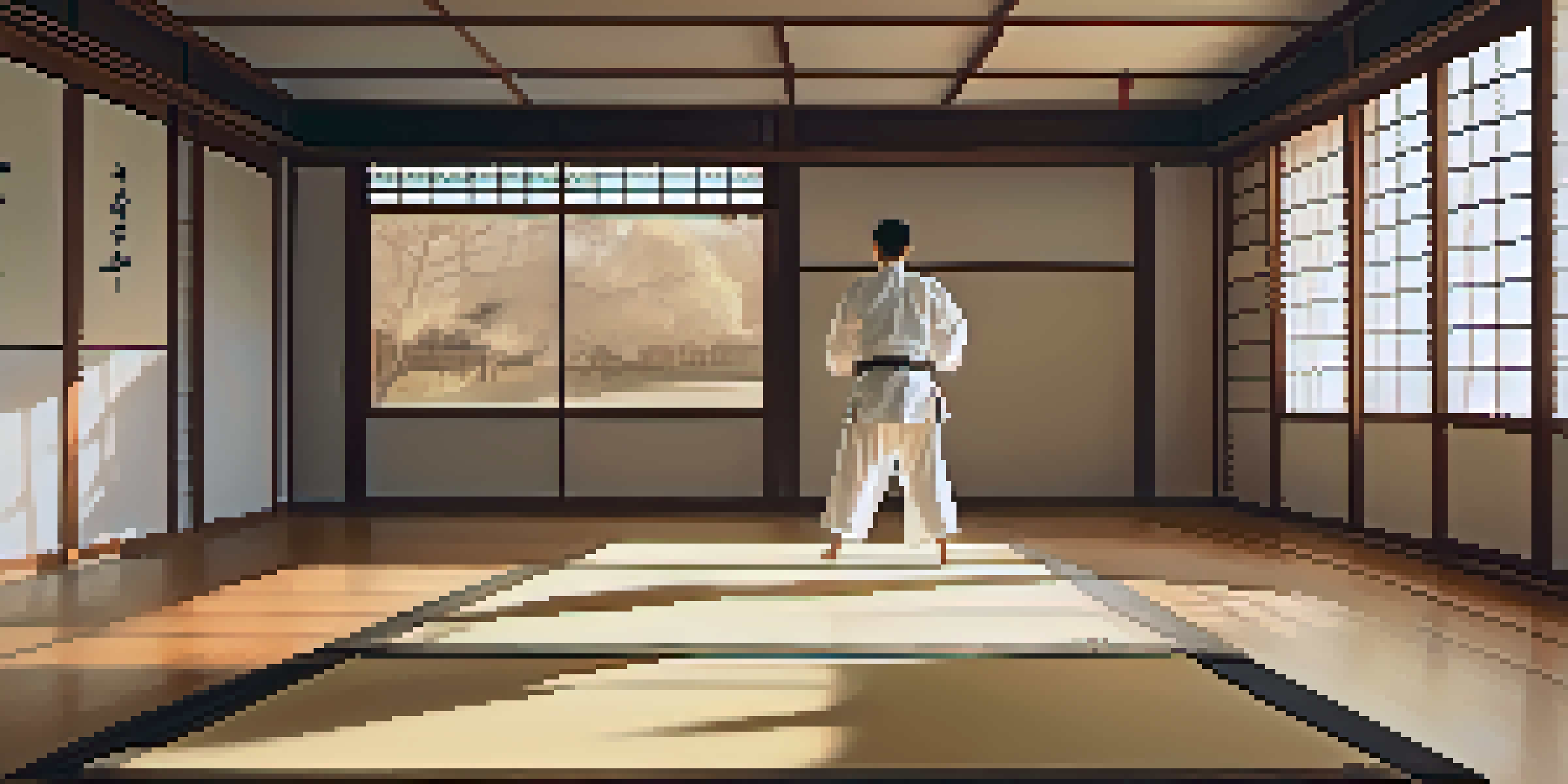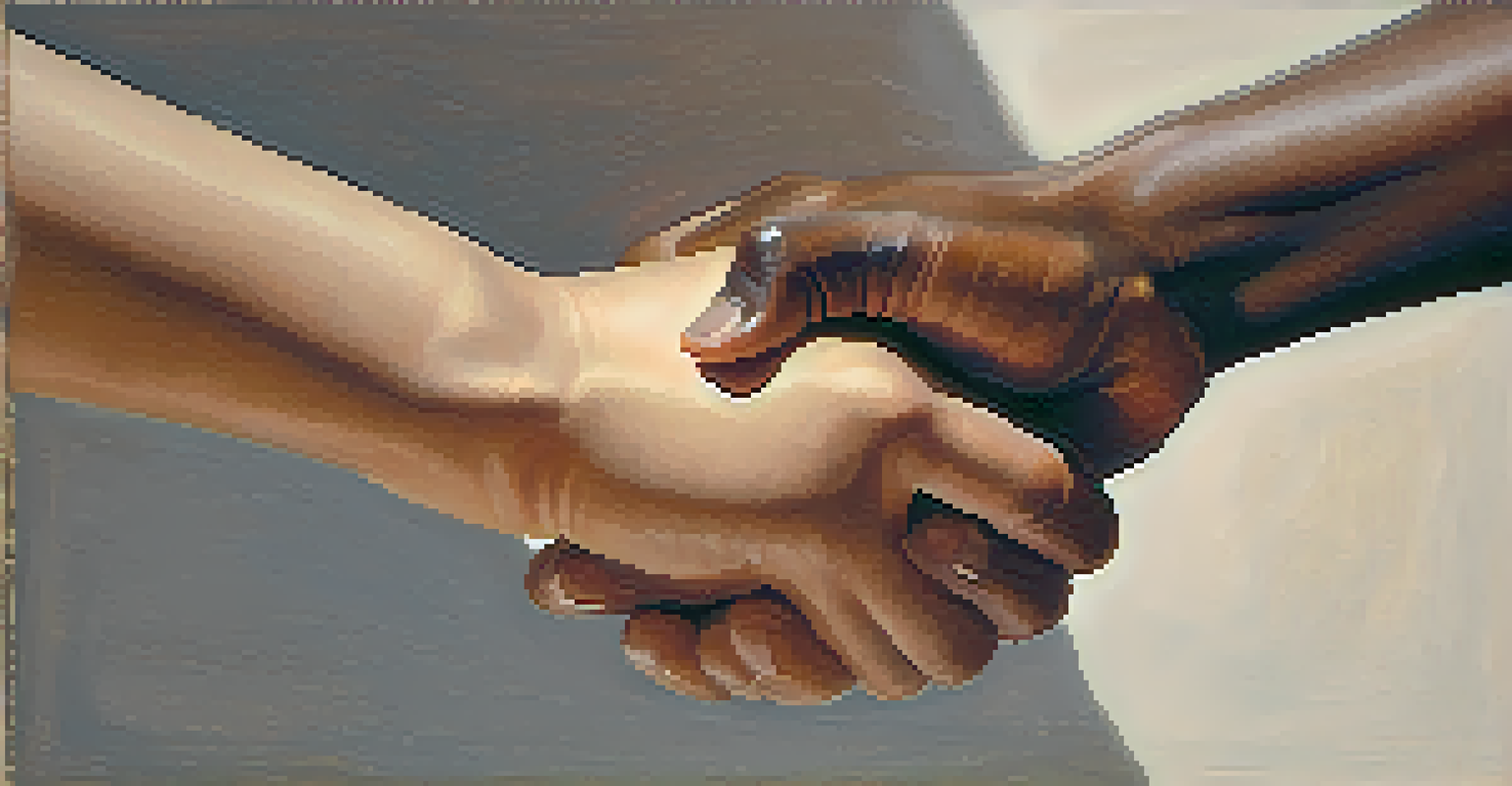Conflict De-escalation: Lessons from Traditional Martial Arts

Understanding Conflict De-escalation in Martial Arts
Conflict de-escalation is the art of reducing tension in a situation, which is a core principle in traditional martial arts. Instead of escalating a fight, martial artists learn to diffuse conflict through awareness and understanding. This practice emphasizes that the goal is not to win but to find harmony and resolution, which can be applied in everyday life.
The greatest victory is that which requires no battle.
For example, a martial artist might use techniques such as redirecting energy or employing non-aggressive stances to calm a potential fight. This approach reflects the belief that the best outcome is one where all parties feel respected and understood. Just as martial arts prioritize self-control, so does effective conflict de-escalation in personal and professional interactions.
By embracing these philosophies, we can better handle disagreements, whether in the dojo or the boardroom. The lessons learned in martial arts teach us that sometimes stepping back and listening can be the most powerful move.
Active Listening: A Fundamental Skill
One of the key strategies in martial arts for de-escalating conflict is active listening. This involves genuinely hearing what another person is saying, which can help in understanding their perspective and feelings. Just as a martial artist must be attuned to their opponent's movements, we should be equally responsive to others' words in a conflict.

For instance, when tensions rise, taking the time to listen can transform a heated exchange into a constructive dialogue. By acknowledging the other person's feelings and concerns, you create an environment where resolution becomes possible. This is akin to a martial artist observing their opponent's stance and intentions before making a move.
Active Listening Reduces Tension
Genuinely hearing others' perspectives fosters empathy and can transform conflicts into constructive dialogues.
Active listening fosters empathy, which is crucial in resolving differences. It not only helps de-escalate immediate tensions but also builds trust and respect for future interactions.
Emphasizing Non-verbal Communication
In martial arts, non-verbal communication plays a vital role. Body language, facial expressions, and gestures can convey confidence and calmness, which can be crucial during tense moments. By being aware of our non-verbal signals, we can communicate a sense of peace and openness, even in conflicts.
In the midst of movement and chaos, when the world is crumbling, I can find the quiet center of myself.
For example, maintaining an open posture while discussing a disagreement can signal that you are approachable and willing to engage. Conversely, crossing your arms or avoiding eye contact may escalate the situation further. Just as a martial artist uses their body to express intent, we can also harness non-verbal cues to promote understanding.
This awareness of non-verbal communication can be particularly effective in high-stress situations. By projecting calmness, we may encourage the other party to lower their defenses and engage in a more constructive manner.
Finding Common Ground: A Shared Goal
A powerful de-escalation technique derived from martial arts is the emphasis on finding common ground. Just as martial artists aim for mutual respect and understanding, we should seek areas of agreement in conflicts. This shared goal can shift the focus from disagreement to collaboration, paving the way for resolution.
For instance, during a disagreement at work, identifying shared objectives can help both parties move past their differences. By recognizing that both sides want a successful outcome, it becomes easier to work together. This approach mirrors how martial artists often train in pairs, fostering teamwork and mutual improvement.
Finding Common Ground Is Key
Identifying shared goals during disagreements shifts focus from conflict to collaboration, paving the way for resolution.
By prioritizing common ground, we can transform adversarial situations into opportunities for collaboration. This shift in perspective is a cornerstone of effective conflict de-escalation.
The Power of Patience and Timing
Patience is another lesson from martial arts that is crucial in conflict de-escalation. Just as a martial artist must wait for the right moment to execute a move, we should also allow time for emotions to settle before addressing a conflict. Rushing into a discussion while tempers are flaring can lead to misunderstandings and increased tension.
For example, if a disagreement arises, taking a step back to breathe and reflect can provide clarity and perspective. This pause allows both parties to cool down and approach the situation more rationally. The martial arts principle of timing teaches us that the right moment can make all the difference.
By exercising patience, we can create space for more constructive conversations. This not only helps in resolving the current conflict but also strengthens our ability to manage future disagreements.
Using Humor to Lighten Tense Situations
In the world of martial arts, humor can serve as a powerful tool for de-escalation. Just as a well-timed joke can diffuse tension during a sparring session, humor can help lighten heated discussions. It brings a sense of humanity and connection that can bridge divides.
For example, sharing a light-hearted moment can remind everyone involved that we are all human and prone to mistakes. It shifts the focus from conflict to camaraderie, allowing for a more relaxed atmosphere. Just as martial artists often share laughs in training, we can also find ways to incorporate humor into our interactions.
Patience Enhances Conflict Resolution
Allowing time for emotions to settle helps create a more constructive environment for addressing conflicts.
However, it's essential to gauge the appropriateness of humor based on the situation. When used wisely, humor can transform the dynamics of a conflict, making it easier to navigate.
Conclusion: Integrating Martial Arts Principles in Life
In conclusion, the principles of conflict de-escalation found in traditional martial arts are not just for the dojo—they can be applied to everyday life as well. From active listening to finding common ground, these strategies can foster healthier interactions in both personal and professional settings. Embracing patience, non-verbal communication, and even humor can dramatically change how we approach conflicts.
By integrating these martial arts lessons into our daily interactions, we can create a more harmonious environment. The ultimate goal is not just to resolve disputes but to build stronger relationships and understanding among individuals. Just as martial artists train for self-improvement, we too can cultivate our skills in conflict resolution.

As we navigate our lives, let’s remember that the spirit of martial arts can guide us toward peaceful resolutions, reminding us that every conflict is an opportunity for growth and connection.